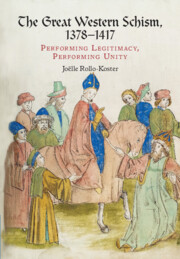Book contents
- The Great Western Schism, 1378–1417
- The Great Western Schism, 1378–1417
- Copyright page
- Dedication
- Contents
- Illustrations
- Maps
- Tables
- Acknowledgments
- Abbreviations
- Introduction
- 1 The Great Western Schism
- 2 Performing the Papacy, Performing the Schism
- 3 Images and Responses
- 4 Conflicting Legitimacy
- 5 Finding Unity in Liturgy
- 6 Rome during the Schism
- 7 Avignon during the Schism
- Conclusion
- Bibliography
- Index
Conclusion
Published online by Cambridge University Press: 24 March 2022
- The Great Western Schism, 1378–1417
- The Great Western Schism, 1378–1417
- Copyright page
- Dedication
- Contents
- Illustrations
- Maps
- Tables
- Acknowledgments
- Abbreviations
- Introduction
- 1 The Great Western Schism
- 2 Performing the Papacy, Performing the Schism
- 3 Images and Responses
- 4 Conflicting Legitimacy
- 5 Finding Unity in Liturgy
- 6 Rome during the Schism
- 7 Avignon during the Schism
- Conclusion
- Bibliography
- Index
Summary
This study has framed the exploration of the Great Western Schism around the cultural anthropological concept of social drama. Social drama entails conflict, while the various searches for a resolution identify the processual evolution of this conflict toward a solution. Social drama initiates with a breach, sides are taken, actions aimed at negotiating an outcome usually follow, and a solution is eventually found. As we saw, the 1378 double papal election initiated a breach such as the Church had never witnessed in its history. Europe divided itself into obediences, while various proposals aimed at ending the crisis were advanced: war, compromise, discussion, cession and subtraction, and eventually councils. Unity was reclaimed at the end of the last of these councils with the elevation of a single pope.
- Type
- Chapter
- Information
- The Great Western Schism, 1378–1417 , pp. 357 - 359Publisher: Cambridge University PressPrint publication year: 2022

